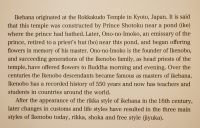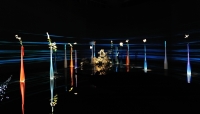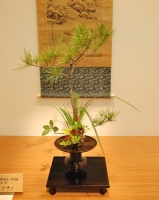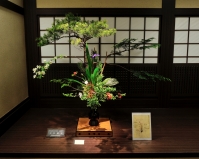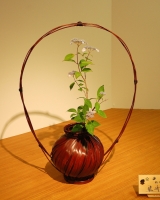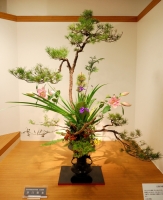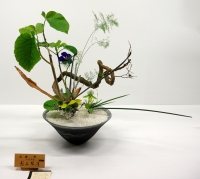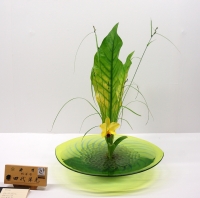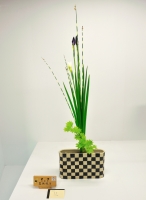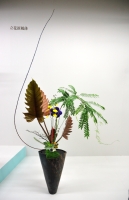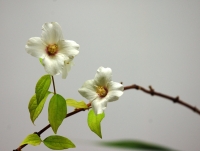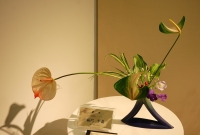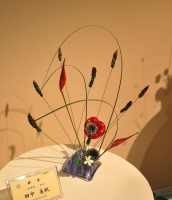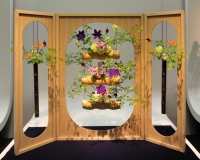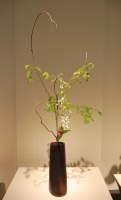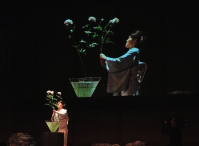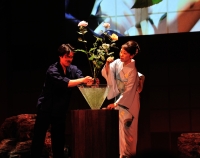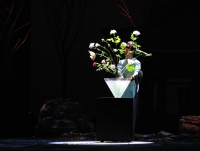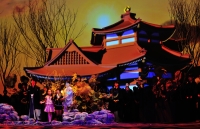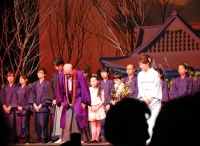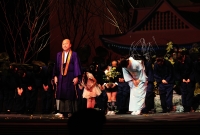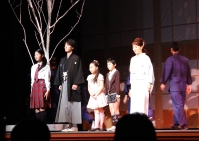|
Prince Regent Shotoku, a strong
proponent of the recently imported Buddhism, sent
Ono-no-Imoko as the second emissary to China in the
year 607. While in China he was exposed to the
practice of arranging flowers as offerings to Buddha,
and continued this tradition using plants growing
naturally in and around the pond. Hundreds of
years later, in the Ashikaga Bakufu (miliary rule)
period (1336–1573), also known as the Muromachi
Period, the civil wars began to settle down and the
arts began to flourish. Flower arranging evolved under
Ikenobo Senkei into something for enjoyment,
paralleling the development of the Way of Tea (Chado) and the
Way of Incense (Kodo).
Floral Art, known as Kado, the Way of Flowers, included
lessons on techniques and appropriate mental attitude,
establishing Ikenobo as the original school of
Ikebana. The original arrangements, called Tatebana,
literally "standing flowers", consisted of a tree
branch called shin,
supplemented by a grass material known as soekusa, or added
grass. Members of the Imperial Court and wealthy
members of society began to display ikebana made to
complement the scene on the hanging scroll in the tokonoma, a
special corner of the sitting room. The oldest
surviving record of this is the Hekizan'nichiroku
of 1462 which records a class of emulating an
arrangement. Tatebana
was often displayed on the left wih an incensor in the
middle and, on the right, a candleholder in the shape
of a crane standing on a tortoise. By 1530 the
name had changed to Rikka
and the rules included seven main branches known as shin, soeuke, soe,
mikoshi, shinkakushi, nagashi and maeoki.
|
|
In the Azuchi-Momoyama (1568-1603) to
early Edo Periods Rikka
and its wider variant, Suna no Mono (aka Sunamono,
literally "sand thing", a low, wide rikka with a base
normally covered in white gravel to resemble sand)
were practiced by the warrior class, adorning the tokonoma in their
smaller sitting rooms. In an extreme example of
this period, the exhibition featured a large sunamono that
recalled the "Maeda Mansion Daisunamono" of 1594 which
was a more than 21 foot wide arrangement the 31st
headmaster of Ikenobo had created to adorn the large
sitting room in the Mansion of the Maeda Clan.
Behind this arrangement hung four scrolls painted with
20 monkeys cavorting. The room-sized replica had
28 names listed as arranging the divided sunamono for the
exhibition. A lighter version of arranging known
as Nageire,
literally "thrown in", developed, leading to the
development of Chabana or a simple more natural
arrangement to accompany the Tea Ceremony. The
32nd headmaster, Senko the 2nd, further developed the
rikka style,
several of which are highlighted on a commemorative
set of stamps showing historical arrangements, several
of which were also emulated for the exhibit.
|
|
In the middle part of the Edo Period
(1603-1868) the Rikka
form developed a refined elegance and the rules for Shoka were
solidified and Ikenobo's reputation increased.
By early the 1800s Japanese culture centered around
life in Edo, where flower stores provided easy access
to seasonal flowers and the affluent town folk began
to decorate their Tokonoma
with Shoka.
In 1820 a scroll appeared showing 100 standard
variations of the Shoka
form. Blown up portions of this scroll decorated
the back wall of part of the exhibition highlighting
this form. By the late Edo period Ikenobo
ikebana was spreading to all parts of Japan with
instruction in Rikka
and Shoka.
Women began taking up the study of ikebana, which had
been a male dominated practice until this time.
In Kyoto alone there were 2000 Flower Associations for
the study of ikebana.
|
|
The restoration of the Emperor and the
Westernization of life in Japan caused great upheaval
in ideas, life and culture in Meiji Era (1868-1912)
Japan. Ikenobo formalized the basic rules for Shoka Shofutai to
have 3 elements known as Shin, Soe and Tai. In
1897 Ikenobo began teaching Shoka Shofutai to women at the Kyoto
Prefectural Women's College. Until this time the
opportunity had only been afforded to men, but this
led to the popularization of learning ikebana as a
refinement for women. Meanwhile the rules for
the use of tree materials increased, adding lots of
detailed condition on the ideal ways to arrange
them. In contrast, the new freedom of thought
and the response to a more natural view of the beauty
of plant materials led to a desire for more freedom in
ikebana. By early Showa Period (1925-1989)
Ikenobo had adapted the rules for Rikka and Shoka into Nageire and Moribana, known
collectively as Ouyoubana
or Adaptation Flowers.
|
|
Ikebana continues to evolve with the
changing lifestyles of today. Many Japanese no
longer have a Tokonoma in which to display a large
arrangement, so they are often smaller and can be
displayed more easily in the modern home. Jiyuka, or
modern free style developed after World War II.
In addition, the current headmaster has introduced
several new styles (Shoka Shimputai
in 1977 and Rikka
Shimputai in 1999) blending traditional
techniques with modern sense of beauty. In
addition, Ikenobo is spreading thoughout the world
with 14 countries represented in the exhibition.
|
 Other Sights in Tokyo
Other Sights in Tokyo
 Roger's Pictures
Roger's Pictures




